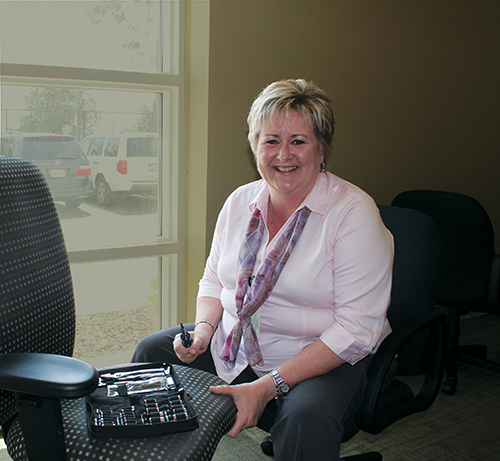Employed Americans ages 25 to 54, with children under age 18, spend an average of 8.8 hours at work during non-holiday workdays, according to the annual 2011 Bureau of Labor Statistics “American Time Use Survey.”
That’s the largest portion of the day, says the survey, with the category of sleeping at 7.6 hours and all other activities 2.5 hours or less.
For many U.S. employees, that translates to working at a desk. While there is no getting around this reality of life, there are ways to reduce the fatigue and pain of long workdays. Less pain and fatigue translates to better productivity—and better morale.
“Many times, there are fairly minor adjustments that can be made to help an employee be more comfortable at work,” points out Lynn Thornstrom, certified ergonomics assessment specialist, department of risk management and abilities accommodation, Loma Linda University Shared Services.
“You shouldn’t feel pain after a day of work,” she continues. “That does not have to be a natural consequence of putting in a good day’s work.”
Ms. Thornstrom spends much of her time following up with employee complaints of pain and discomfort, often related to worker’s compensation claims. “That’s too late,” she insists. “If the employee’s workstation is initially set up to best fit him or her, the worker’s compensation claim can be avoided.”
And so she often carries a simple toolkit with her. It contains most of the tools she would need to make adjustments to an office chair—one of the top reasons why employees develop painful symptoms due to poor posture.
“My favorite part of the job is prevention,” Ms. Thornstrom explains. “I love it when I can educate employees and managers about good ergonomics. That way, I can save the institution major dollars, while at the same time improving the quality of life for employees. Everybody wins.”
Ms. Thornstrom, who worked for a decade or so as an ergonomics consultant, is concerned when some managers think that major costs will automatically ensue following her visit to their area. It’s true that more than a simple chair adjustment may be required in some cases. A new chair may be needed, or even a keyboard tray or footrest.
“To me, that’s a small price to pay for a faithful employee who puts in long hours working diligently for the institution,” she shares. “Actually, I would love to be a part of the workplace design process in the first place, so that the same dollars could be used to purchase ergonomically sound equipment in the first place.”
Office chairs are critical to good ergonomics. They should be fully adjustable and provide good support to the back. The height of the desk has a major impact as well. “Desktops that are too high make it absolutely necessary for employees to have keyboard trays,” she details. “Since every employee comes in a different size and shape, a good keyboard tray can make all the difference.”
Lighting is an often-overlooked part of ergonomics. “Too much light creates major eye strain when viewing a monitor all day,” Ms. Thornstrom informs. “It is better to lower the overall light and accommodate the younger eyes, then provide personal lights to those who need them for desktop/paperwork.”
Before managers imagine their workplace budgets ballooning out of control, Ms. Thornstrom is quick to make an important point. “Lighting under the overhanging storage cupboards is a poor investment in almost every case,” she suggests. “Instead, invest in personal work lights. The institution will save money in the long run, and aging eyes will have the extra light needed to avoid eye strain.”
A footrest may also be beneficial to some employees. By taking pressure off the feet, back pain and other forms of discomfort can be reduced or eliminated.
“I am working to develop a list of ergonomically sound equipment for the institution,” Ms. Thornstrom confides. “Too often, we take the word of a salesperson when it comes to selecting furniture and equipment. We have to remind ourselves that his or her motivations are to move merchandise and make a profit.”
Ms. Thornstrom recognizes her personal limitations. “There are 18,000-plus employees in Loma Linda University Health and only one of me,” she admits. “That’s why I believe that I can have the greatest positive impact educating our employees and managers about the benefits of good ergonomics, and help them create better workstations and working habits in the first place.”

